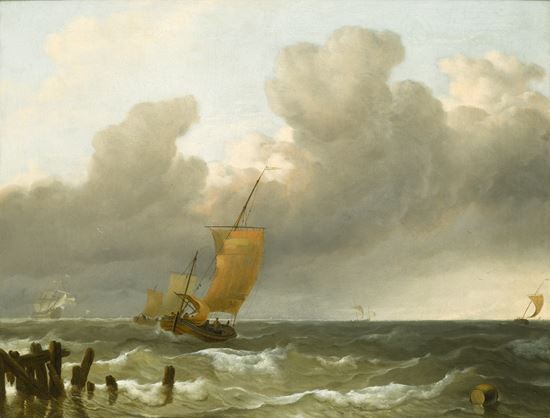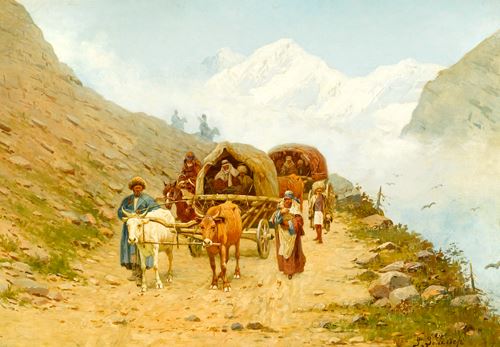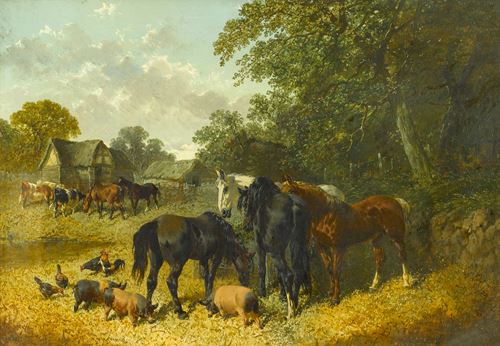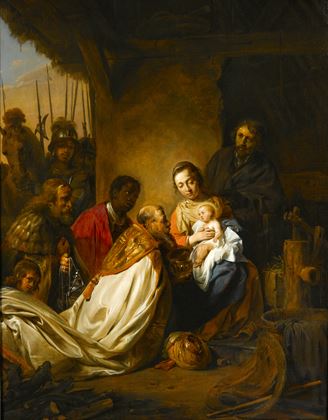udolph Backhuysen
(Emden 1631 - Amsterdam 1708)
Shipping by the Dutch Coast
monogrammed on the barrel 'L.B.' (lower right)
oil on canvas
48 x 62 cm (18¾ x 24⅜ in)
The present work shows a fishing fleet off the Dutch coast navigating choppy waters. In the far background, a Dutch man-o’war can be seen. In the rough water a wooden barrel floats on top of a wave, evidently lost from one of the nearby sailboats, and the underside of the cask is monogrammed with Ludolph Backhuysen’s initials, ‘L.B.’. The sky is dominated by low lying, thick dark clouds, intimating an approaching storm, which is further indicated by the full sails of the fleet, white capped waves and broken water. Backhuysen was an ardent student of nature, and frequently worked from an open boat in order to study the effects of storms. In Shipping by the Dutch Coast, one imagines the artist to be perched on the quayside, from which the broken wooden stilts of an earlier structure still visible, deftly recording the movement and fragility of the ships in the whipped and stormy waters.
Backhuysen was a Dutch painter, draughtsman, calligrapher and printmaker of German origin, though he was primarily active in Amsterdam. Backhuysen was from Emden in north-west Germany and he trained as a clerk in his native town. Shortly before 1650 he went to Amsterdam to work for a wealthy merchant, and it was while working there that his fine calligraphy attracted attention. He also displayed skilled use of the pen in drawings, mainly of marine scenes, completed in black ink on prepared canvas, panel or parchment. He probably derived this technique and subject matter from Willem van de Velde the Elder’s (1611-1693) pen drawings of the 1650s.
According to the Dutch engraver Arnold Houbraken (1660-1719), Backhuysen learnt to paint using oils from the marine painters Hendrick Dubbels (1621-1707) and Allaert van Everdingen (1621-1675). His earliest paintings utilise a silvery palate and are simply composed, echoing the work of his forerunner, Simon de Vlieger (c.1600-1653). The present work, believed to have been completed c.1660-1665, demonstrates the features characteristic of Backhuysen’s early works, such as the more subdued and limited colour palette in comparison to his later, more vibrantly colourful and charged works. Backhuysen did not join the Amsterdam guild of painters until 1663, after which his fame as a marine specialist rapidly grew. In 1665 he was commissioned by the burgomaster of Amsterdam to paint View of Amsterdam and the IJ (now in the Louvre, Paris), intended as a diplomatic gift for Hugues de Lionne, Louis XIV’s Foreign Minister. After van de Velde the Elder and Willem van de Velde the Younger (1633-1707)moved to England in 1672, Backhuysen became the leading marine painter in the Dutch Republic. Unlike the van de Veldes, who were more concerned with representing the technical aspects of sailing vessels and naval battles, Backhuysen concentrated on the ever changing climate and the magnificent skies of the Netherlands. Much of his work venerates Amsterdam and the mercantile trade that had epitomised its Golden Age.
Backhuysen’s success won him important commissions from Cosimo III de’ Medici, Grand Duke of Tuscany, Frederick I of Prussia, Elector of Saxony, and Peter the Great, Tsar of Russia. The artist exerted great influence upon a number of younger artists, including Abraham Storck (1644-1708). The latter was particularly inspired by Backhuysen’s pictorial treatment of sea and sky, as is clealy demonstrated in Review of the Dutch Yachts before Peter the Great (National Maritime Museum, Greenwich, London).
Rev. Elborough Woodcock (1801-1877);
by descent to his son-in-law, Edmund C. Johnson (1821-1895) (according to label on the reverse);
by descent to his son, Stuart Henry James Johnson (b.1869), 4 Eaton Place, London SW1;
sale, Christie's, London, 13 December 1996, lot 220;
with Rafael Valls Ltd., London, 1997.
Rafael Valls: Recent Acquisitions, 1997, no. 1.
The present work shows a fishing fleet off the Dutch coast navigating choppy waters. In the far background, a Dutch man-o’war can be seen. In the rough water a wooden barrel floats on top of a wave, evidently lost from one of the nearby sailboats, and the underside of the cask is monogrammed with Ludolph Backhuysen’s initials, ‘L.B.’. The sky is dominated by low lying, thick dark clouds, intimating an approaching storm, which is further indicated by the full sails of the fleet, white capped waves and broken water. Backhuysen was an ardent student of nature, and frequently worked from an open boat in order to study the effects of storms. In Shipping by the Dutch Coast, one imagines the artist to be perched on the quayside, from which the broken wooden stilts of an earlier structure still visible, deftly recording the movement and fragility of the ships in the whipped and stormy waters.
Backhuysen was a Dutch painter, draughtsman, calligrapher and printmaker of German origin, though he was primarily active in Amsterdam. Backhuysen was from Emden in north-west Germany and he trained as a clerk in his native town. Shortly before 1650 he went to Amsterdam to work for a wealthy merchant, and it was while working there that his fine calligraphy attracted attention. He also displayed skilled use of the pen in drawings, mainly of marine scenes, completed in black ink on prepared canvas, panel or parchment. He probably derived this technique and subject matter from Willem van de Velde the Elder’s (1611-1693) pen drawings of the 1650s.
According to the Dutch engraver Arnold Houbraken (1660-1719), Backhuysen learnt to paint using oils from the marine painters Hendrick Dubbels (1621-1707) and Allaert van Everdingen (1621-1675). His earliest paintings utilise a silvery palate and are simply composed, echoing the work of his forerunner, Simon de Vlieger (c.1600-1653). The present work, believed to have been completed c.1660-1665, demonstrates the features characteristic of Backhuysen’s early works, such as the more subdued and limited colour palette in comparison to his later, more vibrantly colourful and charged works. Backhuysen did not join the Amsterdam guild of painters until 1663, after which his fame as a marine specialist rapidly grew. In 1665 he was commissioned by the burgomaster of Amsterdam to paint View of Amsterdam and the IJ (now in the Louvre, Paris), intended as a diplomatic gift for Hugues de Lionne, Louis XIV’s Foreign Minister. After van de Velde the Elder and Willem van de Velde the Younger (1633-1707)moved to England in 1672, Backhuysen became the leading marine painter in the Dutch Republic. Unlike the van de Veldes, who were more concerned with representing the technical aspects of sailing vessels and naval battles, Backhuysen concentrated on the ever changing climate and the magnificent skies of the Netherlands. Much of his work venerates Amsterdam and the mercantile trade that had epitomised its Golden Age.
Backhuysen’s success won him important commissions from Cosimo III de’ Medici, Grand Duke of Tuscany, Frederick I of Prussia, Elector of Saxony, and Peter the Great, Tsar of Russia. The artist exerted great influence upon a number of younger artists, including Abraham Storck (1644-1708). The latter was particularly inspired by Backhuysen’s pictorial treatment of sea and sky, as is clealy demonstrated in Review of the Dutch Yachts before Peter the Great (National Maritime Museum, Greenwich, London).
Rev. Elborough Woodcock (1801-1877);
by descent to his son-in-law, Edmund C. Johnson (1821-1895) (according to label on the reverse);
by descent to his son, Stuart Henry James Johnson (b.1869), 4 Eaton Place, London SW1;
sale, Christie's, London, 13 December 1996, lot 220;
with Rafael Valls Ltd., London, 1997.
Rafael Valls: Recent Acquisitions, 1997, no. 1.




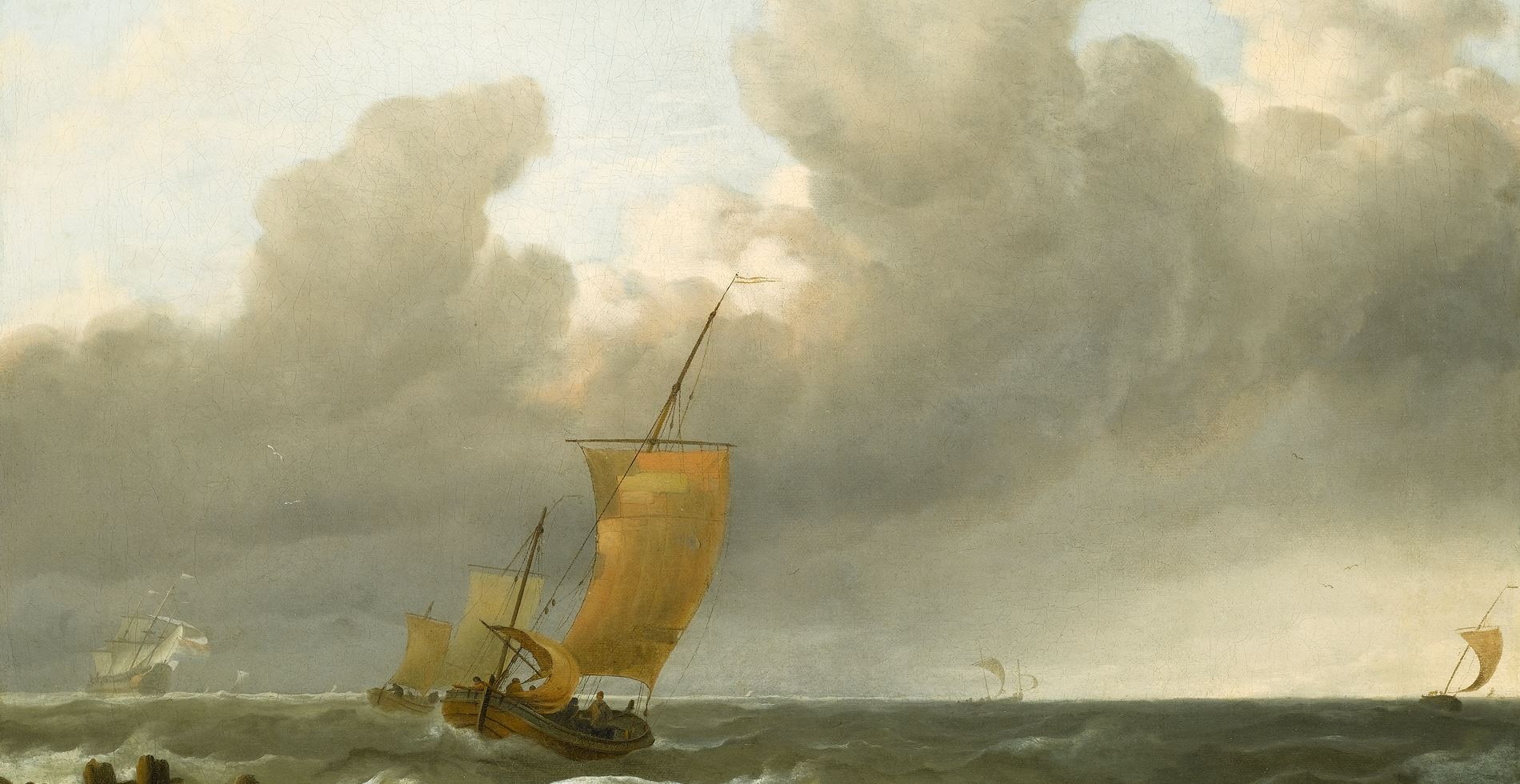
 contact
contact +44 20 7313 8040
+44 20 7313 8040


